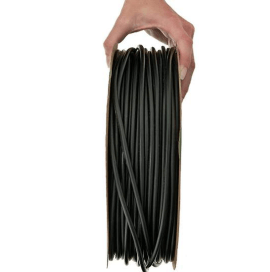Top 5 Easy Fish Breeding Ideas for Your Next 20-Gallon Aquarium
When our founder Cory first got into fishkeeping, funds were tight, so he started breeding fish to help with his hobby expenses. After many years of experience keeping fish rooms and tanks of all sizes, he still loves breeding fish at home in the versatile 20-gallon aquarium (both the high and long versions). Learn about his top 5 favorite fish and invertebrates that are easy to spawn and raise up in a colony setting.
1. Mouth-Brooding Bettas

Betta albimarginata
Most people know about Betta splendens with their large and colorful fins, but breeding them can be hassle since the male juveniles are too territorial to cohabitate and must be raised in individual jars until they reach a sellable size. However, some of the mouth-brooding Betta species are a little more peaceful where males and females can be kept together in a 20-gallon breeding setup. We’ve personally kept and had success with the strawberry betta (B. albimarginata) and Penang betta (B. pugnax), but there are several other species to try like the snakehead betta (B. channoides) and B. rubra. We like to densely plant the aquarium and add tall hardscape to break up line of sight and provide hiding spots for the future fry. A tight-fitting lid is recommended to increase humidity and prevent fish from jumping out. You can even consider adding some small dither fish like neon tetras to swim out in the open and break up any aggression. Most of these bettas prefer acidic, tannin-stained water, so don’t forget to add catappa leaves and other botanicals.
After the female has spawned and the eggs are fertilized, the male is responsible for holding the brood in his mouth for the next 1.5–3 weeks. Once the babies have hatched and are freely swimming, the male will spit them out and they must fend for themselves. The fry are usually big enough to immediately eat baby brine shrimp, which is an amazing superfood that will help them grow fast and strong. Just know that the male cannot eat while he is holding eggs, so to prevent him from losing too much weight, put the female into a separate tank or breeder box until he has time to regain his mass before breeding them again. As the tank becomes more crowded, remove the juveniles to make room for the next brood and prevent territorial disputes.
2. Dwarf Shrimp

Neocaridina davidi
If you want to breed something that’s in high demand and easy to sell, then dwarf shrimp are the way to go. There are many species to choose from — such as Neocaridina cherry shrimp, Caridina crystal shrimp, and even Sulawesi shrimp — so select a type that works best with your normal tap water’s parameters. Dwarf shrimp are scavengers that love picking through all the mulm and gunk in your aquarium, so they do best in a well-seasoned tank that has been running for many months. While it’s nice to keep them in a beautiful planted aquascape, they would be just as happy in an algae-filled setup because of all the free food to graze on. For filtration, use a sponge filter with gentle flow (or put a pre-filter sponge on the intake of your hang-on-back or canister filter) to prevent any tiny babies from being sucked up.
If your goal is to produce as many shrimp as possible, then keep a species-only aquarium with no other tank mates. However, if you want a livelier aquarium, then you could add other nano fish like chili rasboras and green neon tetras. Feed them heavily so they’ll be less likely to munch on the colony and add more hiding spots for the baby shrimp to escape. For more ideas, read our article on the top 12 tank mates to keep with dwarf shrimp.
3. Fancy Guppies

Poecilia reticulata
Another aquatic animal that is super popular and easy to breed is fancy guppies. Like most livebearers, just provide good water and food and they’ll reproduce like rabbits. The parents will predate on their own young, so to increase your numbers, add lots of plants like water sprite and Pogostemon stellatus ‘octopus’ where the small babies can take cover and the adults have a harder time reaching them. You can choose to breed a tank full of random, mixed colors or try to work on a single, pure stain. In both cases, be prepared to cull the fry and remove any young that show deformities or throw undesirable features that would mess up your line breeding efforts. For more details on colony breeding for livebearers like guppies, read the full article.
4. White Cloud Mountain Minnows

Tanichthys albonubes
Most hobbyists think of egg layers as much harder to breed and raise compared to livebearers, so if you’ve never tried it before, white cloud minnows are a great entry-level fish. Because they are sold as feeder fish, Cory originally bought a group of them for cheap and then was surprised when he accidentally bred a ton of them. Encouraged by his success, he went on to run the “White Cloud Race” at his local fish club where contestants would start with six minnows and see how many they could make over the summer season. This beginner-friendly fish is quite hardy and can even be kept outside in mini ponds during the warmer months. As long as you don’t have too many snails or other fish with them, the fry can be raised up with the adults in the same colony. It’s the older juveniles that will sometimes prey on their younger siblings, so add plenty of dense, fluffy plants for shelter and keep moving out the teenagers to increase the fry survival rate. To learn more about their husbandry and the different color variants, read our care guide.
5. Desert Gobies

Chlamydogobius eremius
After several years in the fishkeeping hobby, you may get to the point where you feel like you’ve already bred all the common species, like guppies and shrimp. What kind of oddball fish can you find that is still easy to reproduce? Enter the desert goby. While it’s not the most colorful fish out there, we love their unusual appearance and unique behaviors. They can go in community tanks but most of the babies will probably end up as food, so we like to keep them in a species-only setup for the purposes of breeding. They have large mouths and can get a little territorial during spawning seasons, so provide lots of hides for the subdominant adults. To encourage breeding, add a 0.5-inch (1.3 cm) PVC pipe and watch them lay eggs inside. Once they hatch out, you’ll spot little fry scooting around on the ground. They aren’t as high-yielding as livebearers so don’t expect to build a huge colony, but they are a really cool fish that many people haven’t played with before.
Best of luck with your next 20-gallon breeding project. While we don’t ship live fish, you can browse the stocking lists of our preferred online retailers to see what they have available. For more tips and tricks, check out our favorite articles on breeding aquarium fish.




